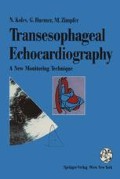Abstract
Afterload can be thought of as the tension acting on the fibers in the ventricular wall during ejection or as the impedance to ejection.1 Although it is influenced importantly by the arterial pressure, it is not synonymous with peripheral arterial pressure, peripheral vascular tone, or systemic vascular resistance. Afterload is best defined as left ventricular wall stress during ejection according to La Place’s law:2
where P is the intracavitary pressure, R is the radius of curvature, and h is the wall thickness. Thus, wall stress is directly related to chamber dimension, and inversely related to wall thickness. While arterial pressure is related to the product cardiac output and systemic vascular resistance, afterload (wall stress) is a function of ventricular size and arterial pressure. Fig. 5.1. illustrates the great difference between wall stress, i.e., afterload, and systolic ventricular pressure.
Access this chapter
Tax calculation will be finalised at checkout
Purchases are for personal use only
Preview
Unable to display preview. Download preview PDF.
References
Braunwald E, Sonnenblick EH, Ross J Jr. Mechanisms of cardiac contraction and relaxation. In: Braunwald E, ed, Heart disease. 4th ed. WB Saunders, Philadelphia, pp 351–418, 1992
Goertz AW, Lindner KH, Seefeld C, Schirmer U, Beyer M, Georgieff M. Effect of phenylephrine bolus administration on global left ventricular function in patients with coronary artery disease and patients with valvular aortic stenosis. Anesthesiology 78: 834–841, 1993
Kaplan J A. Cardiac Anesthesia. 3rd ed. Grune and Stratton, New York, London, pp 1178, 1991
Kikura M, Shanewise JS, Levy JH. Intraoperative assessment of myocardial function. Curr Opin Anesth 4: 42–52, 1993
Grossman W, Jones D, McLaurin LP. Wall stress and patterns of hypertrophy in the human left ventricle. J Clin Invest 56: 56–64, 1975
Lang LM, Briller RA, Neumann A, Borow KM. Assessment of afterload. In: Kreber RE, ed, Echocardiography in coronary artery disease. Future, Mount Kiosk, pp 224–225, 1988
Quinones MA, Mokotoff DM, Nouri S, Winters WL, Miller RR. Noninvasive quantifi-cation of left ventricular wall stress. Validation of the method and application to assessment of chronic pressure overload. Am J Cardiol 45: 782–790, 1980
Huemer G, Kolev N, Kurz A, Zimpfer M. Influence of positive end-expiratory pressure on right and left ventricular performance assessed by Doppler two-dimensional echocardiography. Chest 106: 67–73, 1994
Golan SD, Borow KM, Neumann A. Effects of loading conditions and contractile state (methoxamine and dobutamine) on left ventricular early diastolic function in normal subjects. Am J Cardiol 55: 790–796, 1985
Reichek N, Wilson J, St J Sutton M, Plappert TA, Goldberg S, Hirshfeld JW. Noninvasive determination of left ventricular end-systolic stress: validation of the method and initial application. Circulation 65: 99–108, 1982
Kikura M, Ikeda T, Kazman T, Ikeda K. Effect of prostaglandin Ej on myocardial contractility in dogs anesthetized with halothane: Load-independent and noninvasive assessment using transesophageal echocardiography. J Cardiothorac Vase Anesth 6: 586–592, 1992
Kikura M, Ikeda K. Comparison of effects of sevoflurane-nitrous oxide and enflurane- nitrous oxide on myocardial contractility in humans: load-independent and noninvasive assessment with transesophageal echocardiography. Anesthesiology 79: 235–243, 1993
Douglas PS. Comparison of echocardiographic methods for measurement of left ventricular shortening and wall stress. J Am Coll Cardiol 9: 945–949, 1987
Smith JS, Benefiel DJ, Beaupre PN, Sohn YJ, Lurz FW, Bird B, Bouchard A, Schiller NB, Cahalan MC, Roizen MF. Effects of phenylephrine on myocardial performance during carotid endarterectomy (Abstr). Anesthesiology 61: A56, 1984
O’Kelly BF, Tubau JF, Knight AA, London MJ, Verrier ED, Mangano DT. Measurement of left ventricular contractility using transesophageal echocardiography in patients undergoing coronary artery bypass grafting. Am Heart J 122: 1041–1048, 1991
Cunningham AJ, Turner J, Grosso L, Rosenbaum S, Rafferty T. Transesophageal assessment of hemodynamic function during laparoscopic cholecystectomy (Abstr). Anesth Analg 76: S64, 1993
Colan SD, Borow KM, Neumann A. The left ventricular end-systolic wall stress- velocity of the fiber shortening relation: A load independent index of myocardial contractility. J Am Coll Cardiol 4: 715–719, 1984
Colan SD, Borow KM, Neumann A. Use of the calibrated pulse tracing for calculation of left ventricular pressure and wall stress throughout ejection. Am Heart J 109: 1306–1310, 1985
Janz RF. Estimation of local myocardial stress. Am J Physiol 242: H875, 1982
Kolev N, Huemer G, Ihra G, Spiss CS, Zimpfer M. Assessment of afterload in case of regional systolic abnormalities. Int J Anaesth (in press), 1995
Author information
Authors and Affiliations
Rights and permissions
Copyright information
© 1995 Springer-Verlag/Wien
About this chapter
Cite this chapter
Kolev, N., Huemer, G., Zimpfer, M. (1995). Assessment of afterload. In: Transesophageal Echocardiography. Springer, Vienna. https://doi.org/10.1007/978-3-7091-7676-4_5
Download citation
DOI: https://doi.org/10.1007/978-3-7091-7676-4_5
Publisher Name: Springer, Vienna
Print ISBN: 978-3-211-82650-8
Online ISBN: 978-3-7091-7676-4
eBook Packages: Springer Book Archive

